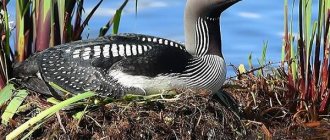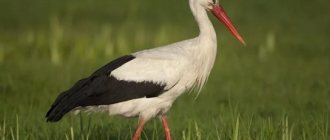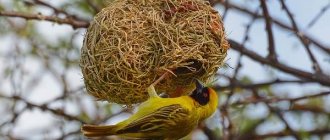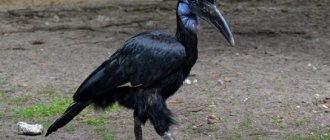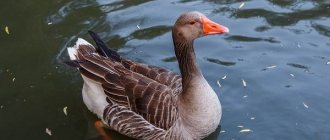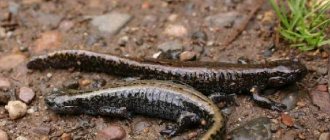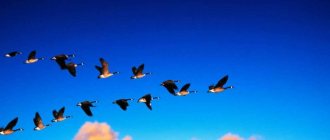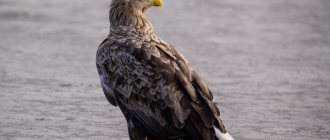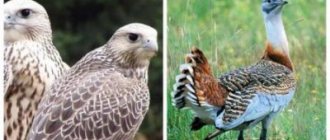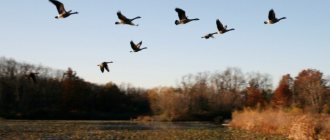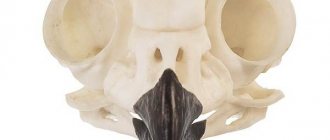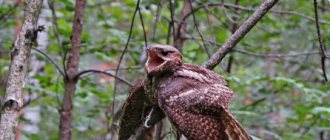Home » Other animals
Classification Genus: Grouse (Lyrurus)
Family: Pheasantaceae
Order: Galliformes
Class: Birds
Type: Chordata
Kingdom: Animals
Dimensions: adult body length 50 - 70 cm, wing length 25 - 30 cm, tail length 9 - 11 cm. Bird weight 1000 - 1500 g.
Life expectancy: 10 -11 years.
The forest-steppe expanses of Europe and Asia are home to a beautiful bird with very bright plumage - the black grouse.
Despite the fact that black grouse prefer to settle in more closed landscapes with tall trees, these representatives of birds are found even in undergrowth with sparse vegetation.
This type of bird does not only need a closed area; accordingly, it can easily be found, like the bustard , in the steppe zone.
Also, the habitat of the black grouse has spread to parts of northern Africa and Scandinavia, but local populations are not as numerous as in the vast expanses of Russia and central Europe.
Grouse are not migratory birds. They spend the winter in the same open spaces where they live. Sometimes, due to changing external factors, birds have to migrate, but often the flight distance is very short.
You can read about which birds fly south in the fall in the article
- 2 Habitats
- 3 Lifestyle
- 4 Reproduction and nesting
- 5 Chicks
- 6 Types of black grouse
- 7 Black grouse hunting
Description of the bird
Grouse in flight photo
Grouse is a fairly large bird with a small head and a short beak. Males are larger in size than females, their body length is from 49 to 58 cm, their weight is in the range of 1-1.4 kg, and females reach a length of 40 to 45 cm, and their weight is 0.7-1 kg.
Plumage
— Advertising —
Sexual dimorphism is also pronounced in the color of the black grouse's plumage.
Male plumage
The male has shiny black plumage with a purple or green sheen on the head, neck, craw and loin, and bright red eyebrows. The back of the belly is brown with light tips of the feathers; the undertail is white. The primary flight feathers are dark brown in color, with “mirrors” - white spots on the lower half of feathers 1 to 5. The “mirrors” are even more pronounced on the secondary flight feathers. The tail feathers are black with a purple sheen at the tips; The outer tail feathers are curved to the sides, which is why the black grouse has a lyre-shaped tail.
Female plumage
The female is motley, reddish-brown in color with transverse stripes of gray, dark yellow and black-brown. Outwardly, it resembles a female capercaillie, but is distinguished by white “mirrors” on the wings and a small notch on the tail. The undertail is white. Young birds have variegated feathers, their color consists of stripes and spots of black-brown, yellow-brown and white.
Grouse
The hazel grouse is one of the smallest members of the fritillary family. It is a sedentary species, nesting throughout Northern Eurasia in the Far East, like Hokkaido, and in the West, like Central and Eastern Europe, in dense, humid, mixed coniferous forests.
This is a relatively small bird. This plump bird's plumage is finely patterned, but essentially has gray upperparts, brown wings and chestnut white underparts. The male has a short crest and a white black throat. The female has a shorter crest and does not have the black color on her throat. In flight, the tail appears gray and has a black tip.
This bird feeds on terrestrial plant matter, supplementing its diet with insects during mating.
Hunting for hazel grouse can take place not only in the spring (during the mating period), but also in the fall. Please note that these birds can be present in twos, as the male loves to pay attention to the female during the mating season. When hunting, use agile dogs.
What does it eat?
Grouse in a photo field
– Advertising –
Black grouse feed mainly on plant matter.
Nutrition during the nesting period
During the nesting period, when the presence of protein food in the diet is important, birds collect cotton grass inflorescences, birch buds, larch and alder buds, heather shrubs and herbs, for example, marsh marigold and buttercups.
Nutrition in summer and autumn
In summer and autumn, black grouse willingly eat berries (blueberries, lingonberries, blueberries, cranberries), leaves of clover, aspen, cuffs, blueberries, hawkweed inflorescences, and bird cherry fruits. If grain crops are grown nearby, then black grouse feed in the fields, eating grains of wheat and millet.
Food in winter
In winter, the black grouse's diet consists of shoots, buds and catkins of birch, and if there is little of it growing, then the bird also feeds on parts of other plants, for example, spruce needles, juniper needles and berries, larch shoots, young pine cones, willow and alder buds.
Feeding the chicks
After birth, chicks feed mainly on animal food: insects and other invertebrates, but gradually switch to plant food familiar to adults.
Chicks
In the southern regions of its habitat, the first black grouse chicks appear already in mid-July. The chicks emerge from the egg very quickly.
It only takes a few hours to hatch the shell. The newly born black grouse chicks weigh no more than thirty grams. And what’s most interesting is that they immediately leave the nest.
The nomadic period for chicks and female black grouse lasts about a month. During this period, the diet includes, in addition to plant foods:
- small insects;
- larvae;
- worms
Young offspring, even after leaving their mother, are still attached to the same territory for some time.
Black grouse chicks have camouflage feathers.
Distribution
Black grouse distribution photo
Area
The habitat of the black grouse includes forest, forest-steppe and steppe zones of Europe and Asia, ranging from the Alpine Mountains and the British Isles in the west to the Ussuri Territory and the Korean Peninsula in the east.
Habitats
In western and central Europe, black grouse live in mountainous forests, at altitudes from 1400 to 1800 m above sea level, although previously their range was much wider. Typically, black grouse prefer to settle where forest or bush thickets are combined with open terrain, for example, in groves, copses, woodlands, river valleys, along the edges of swamps, meadows and agricultural land. Most often, black grouse choose places where birch groves grow.
Migratory behavior
Black grouse is a sedentary or nomadic bird. Its seasonal movements are irregular, and are usually associated either with a lack of food in winter or with changes in population numbers.
Woodcock
This bird can be found in many forests in the CIS, except for the northern part of the region. This is perhaps one of the few birds that fly to warmer climes. Woodcocks return in April, after which their active lifestyle begins, which any upland game hunter should take note of.
Woodcock is found in dark and dense forests, where there are many ravines and wet country roads. The bird's diet consists of various larvae and invertebrates, which it searches for on the ground and near trees, but can also feed on plant foods.
During the “spring rush,” when birds are very active, hunting them is especially interesting. But besides this, you can hunt unusual birds in the summer and autumn, after mating and during the hatching of the chicks.
Upland game includes not only these birds, which we described in the article. This group includes many other species, but all their habits, lifestyle, diet and reproduction are the same. It will not be difficult to understand other subspecies of upland game, so that your hunt will be effective and bring many trophies.
Common types
Caucasian black grouse (Lyrurus mlokosiewiczi)
Caucasian grouse (Lyrurus mlokosiewiczi) photo
Outwardly, the bird is similar to the common grouse, but differs from it in its small size and shape of the tail.
The male’s body length is from 50 to 55 cm, weight is about 1.1 kg, the plumage is matte velvety black, there is no “mirror” on the wings, red eyebrows, a lyre-shaped tail, forked. The female’s body length is from 37 to 42 cm, weight is approximately 0.95 kg, the plumage is motley, reddish-brown in color with dark streaks.
The species is endemic to the Caucasus in Russia, Azerbaijan, Armenia, Georgia, and Turkey. The bird leads a sedentary lifestyle. Lives at altitudes up to 3300 m above sea level, nests slightly lower. It lives in bush thickets of rhododendron and rose hips, as well as in small groves overgrown with low-growing birch and juniper.
Population and species status
Black grouse live over large areas, and their populations are quite large. Due to these circumstances, these birds have been given the status of Least Concern. Caucasian grouse are considered endemic and are therefore classified as Near Vulnerable. The main threat to the life of this species is grazing by livestock, as well as the activities of poachers. Livestock destroys grouse nests, causing the death of chicks and egg laying. Herding dogs will not miss the opportunity to hunt these birds.
Important fact! Caucasian black grouse are protected, living in the territory of such reserves as the Caucasian and Teberdinsky, including other reserves.
Black grouse are large birds that prefer to live in forest plantations of the Euro-Asian continent. They especially like to settle in birch groves. Males differ from females by having brighter and more contrasting plumage colors. It is worth noting a significant difference in color, since the color of the plumage of females is more designed for low visibility, which is very important during the period of birth of offspring, as well as during the period of incubation of eggs. The behavior of these birds is quite attractive and interesting, which served as a source for writing fairy tales, for the appearance of various legends, etc.
A person who managed to observe the mating of these birds talks about it as some kind of mesmerizing spectacle. Therefore, it is not at all surprising that alpine dances contain movements that are associated with the movements of these birds on lekking: these are bows and jumps. In other words, these birds served as a source for folk art of many nationalities.
Male and female: main differences
Female black grouse photo
The first manifestation of sexual dimorphism in black grouse is the larger size of females compared to males. In addition, the male's plumage is black with a purple or green sheen, and his eyebrows are bright red. The belly is brown, the undertail is white. And the female has motley plumage, reddish-brown with transverse stripes of gray, dark yellow and black-brown.
Habitat
The steppe grouse lives in the forest and forest-steppe natural zones of Eurasia. Birds of this species can be found less frequently in the highlands and dry steppes. The northern border of the range is Norway and the British Isles. In Western Europe, due to land cultivation, the habitat of the killer whale has narrowed to the pre-Alpine region.
The southern border of the range runs along the Ukrainian Polesie, the Russian Kursk and Volgograd regions, the Samara and Ural rivers. Birds of this species can be found in Kazakhstan, Mongolia, China and North Korea. Unlike their close relative the black grouse, koschi shun forests with thick trunks. Birds love groves of young birch trees, as the buds of this tree are their preferred food in winter.
Orcas can often be found in meadows with wild cereals, in woodlands, berry patches, heather heaths, on the banks of swamps, in floodplains of rivers, and thickets of bushes. In the mountains it lives on the borders (usually lower, but also found near the upper) of the forest. In Russia, depending on the region, braids are divided into 8 subspecies. But they differ from each other slightly.
Reproduction
Black grouse chick photo
Black grouse is a polygamous bird. At the beginning of spring, males gather at “lekking sites,” open places in the middle of the forest and “lekking,” that is, they behave animatedly, muttering, screaming and chasing each other. There are usually from 10 to 15 males on one lek. Active mating lasts about two weeks. Each male has his own area for mating on the ground; they rarely climb trees. Males often behave quite aggressively towards each other, getting into fights and driving them away from females. After the males, the females arrive at the mating site and choose a partner.
After mating, males do not participate in building the nest, incubating eggs, or raising offspring.
Nest
The female builds a nest next to the lek. It is a depression in the ground, lined with last year's grass, leaves, twigs and feathers. The nest is located at the edge of the forest, under birches, junipers, and in nettle thickets.
Laying eggs
The female lays eggs in mid-May, and the first chicks are born about a month later. In one clutch there are from 5 to 13 (usually 7-9) light ocher eggs with brown or brown spots. The incubation period is about 25 days.
Chicks
The chicks are born in thick fluff and after a couple of hours leave the nest and follow the female. The first 10 days of life are the most dangerous for babies. During this period, the female constantly monitors them, listens to extraneous sounds and, when a predator approaches, tries to lead him away. To do this, the female pretends to be “wounded”; she runs, spreading her wings, jumps and cackles loudly. Hearing the alarming cries of their mother, the chicks scatter and quietly wait out the danger. At 10 days old grouse can already flutter, and at the age of 1 month they begin to fly.
All this time, the males are molting, they hide and behave extremely carefully.
Bird habitat and lifestyle
Black grouse can be found in the Palaearctic and Neo-Arctic zones. The areas from the Pyrenees to the east of Manchuria, the lands of Scotland and Mongolia, the countries of North America, Asia and Europe are inhabited by these interesting and attractive birds. Many of their species can be found in Russia.
This is a sedentary bird, but during the nesting period it is especially scrupulous about where exactly to build a home. At this time, the black grouse tries to avoid gloomy, dense forest areas with tall trees.
They feel wonderful and comfortable in linden and aspen forests, where birch forests, fields with cereals, and berry fields can be seen. Not so long ago it was possible to observe these birds in the steppes. But with the development of agriculture, they gradually left there.
Birds choose the ground for their nests. Right on it, in dense bushes or thickets, black grouse find refuge for themselves. It happens that they simply use a hole in the ground for this.
In the matter of housing, all responsibility falls only on the female. The representative of the stronger sex does not take the slightest part in this. Feathers and dried grass are used to insulate finished housing. Birds prefer to lead a flocking lifestyle. In winter, it is especially important for grouse to stay together. The female rarely leaves her male at this time of year.
During the spring months, birds move through the trees in search of fresh buds and shoots. It's interesting to watch them at this time. The black grouse clings to a branch with its strong paws and can hang upside down for so long.
They lead a sedentary lifestyle and are not accustomed to changing their place of residence. This is the reason for the almost complete destruction of some of their species, because it is not so difficult for hunters to find them.
The mating time of black grouse occurs at the beginning of spring. They go into pairs. Until autumn, the black grouse takes care of its offspring, hatches and carefully protects them. As winter approaches, the birds gather in flocks again. At this time, they are most often found in trees, although the black grouse is considered a terrestrial bird.
Birds fly well. During the daytime, they fly from tree to tree in search of food, and at night they descend to the ground. In winter, they crawl deep into the snow to spend the night, thus escaping the cold. They can spend several days there if the outside temperature drops significantly. But even when under the snow, birds are extremely careful.
They have ideally developed vision and hearing. This helps them anticipate danger in advance. All you have to do is make one wrong move while hunting and you can scare away all the black grouse. Frightened birds fly up quickly and noisily, causing a commotion around.
This bird is of commercial value, so classic black grouse hunting is a favorite pastime of many hunters. Such mass extermination has led to the fact that some species are on the verge of extinction and are taken under the protection of humanity.
Interesting Facts
Photo of black grouse in nature
- Black grouse often appear on postage stamps of various countries. The Caucasian black grouse is depicted on the 1 ruble silver coin, which was issued by the Bank of Russia on October 24, 1995.
- In Russia and the Scandinavian countries, grouse is one of the most popular commercial game birds; the number of carcasses shot is greater only for partridge and hazel grouse. In the early 1990s, about 120,000 individuals of these birds were shot annually in Russia.
Tundra partridge
The mountain partridge breeds in hilly or mountain tundra. They prefer slopes and high valleys where tall shrubs form a variegated pattern with short grasses. The summer range of the tundra partridge is often adjacent to the range of the willow partridge, which nests on higher, drier, rockier soil. In winter, most male tundra partridges are at the lower limit of the breeding range. They move to the hills bordering large valleys, where they winter in scrubby, open habitats. On the territory of our country, this type of partridge can be found in the north of the Ural Mountains, in the Yakut tundra, in Taimyr, on the Kuril Islands, Altai and many other northern regions.
Male tundra partridges have a black mask from beak to ear in winter, which contrasts effectively with the white body plumage. Most females do not have a mask, but about one female in five has a partial black stripe on the front and back of the eye. Like the willow partridge, both sexes have black tail feathers tipped with white. However, the narrower beak of the mountain partridge clearly distinguishes it from the willow partridge. When females begin brooding in early June, they are almost entirely brown except for their white wings. Males retain their winter plumage until early June, then rapidly molt into finely toothed, dark brown summer plumage.
The food of tundra partridges is very varied and consists of such gifts of nature as leaves and berries of blueberries and blueberries, moss, buds of various trees, and seeds. Those birds that live in the Far East eat pine nuts with pleasure, but it is almost impossible to find animal food in their diet.
Tundra partridges can go on migrations, from where they return when the snow actively begins to melt. Keep this in mind when going hunting.
Caucasian black grouse
This species is listed in the Red Book. The Caucasian is smaller than the common one, has a matte black color, and the end of its tail is bent down. The differences are clearly visible in the photo of black grouse and Caucasian grouse. The latter is very similar in habits and way of life to its more common and numerous brother. Lives mainly in the Caucasus.
Grouse - bird of the Russian forest
Grouse is a famous character in the children's fairy tale “The Fox and the Black Grouse.” The hero is reasonable, measured, with self-control and restraint. What hunters really know about him are those who have studied his character and call the black grouse in their own way: black grouse, field cock, birch grouse or braid. The female also has many affectionate names: black grouse, killer whale, hazel grouse, and pole.
